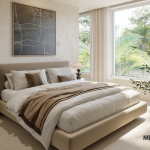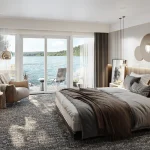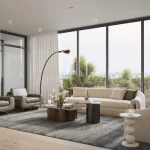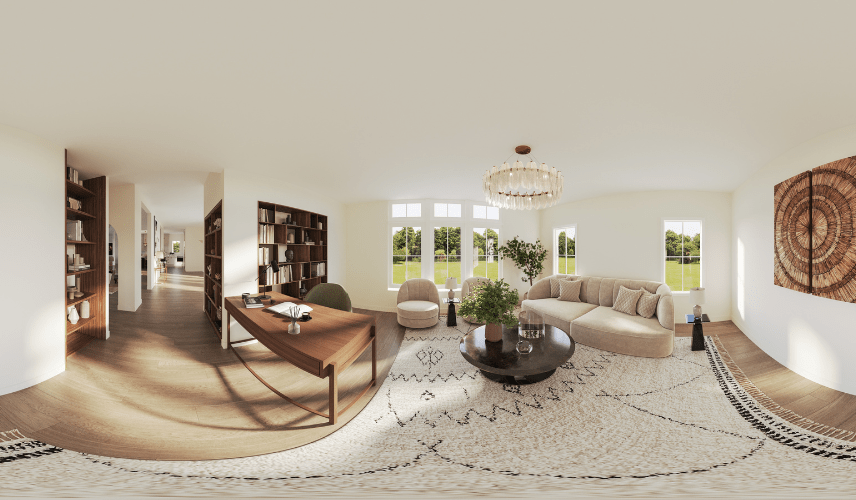
Virtual tours of houses are changing how buyers explore real estate by offering the ability to view homes remotely from anywhere in the world. This technology is especially useful for those relocating, starting their search, or refining their options, as it allows viewing properties anytime without geographical or scheduling constraints. While virtual tours provide an immersive way to understand a home’s layout, features, and feel, confident purchasing decisions depend on using these tools thoughtfully and strategically. This guide covers everything needed to effectively leverage virtual tours, helping buyers make smarter, well-informed choices before physically visiting a property.
In this comprehensive guide, we’ll walk you through everything you need to know about using virtual tours of houses effectively, helping you make informed decisions without setting foot on a property until you’re ready.

Elegant Home Office with a Library Lounge
What are virtual tours of houses?
Virtual tours of houses are digital representations that allow potential buyers to explore properties remotely. They’ve evolved far beyond simple photo galleries. Modern virtual tours of houses typically fall into several categories:
360-Degree Walkthroughs capture every angle of a room, allowing you to pan, zoom, and look in all directions as if you’re standing in the space. Live guided tours connect you with a real estate agent or representative in real-time, enabling interactive questions and personalized property exploration. Augmented reality (AR) tours let you visualize furniture placement or renovations overlaid onto the actual space. Some platforms even offer drone footage showing exterior features and neighborhood context.
The key distinction between virtual tours of houses and traditional photos or videos is the level of interactivity and spatial understanding they provide. While static photos show specific angles, virtual tours of houses create an immersive experience that more closely mimics walking through a home in person.
Key benefits of virtual tours for homebuyers
Virtual tours of houses offer numerous advantages that have made them an essential component of modern home buying.
Convenience and accessibility stand as the primary benefit. Virtual tours of houses eliminate geographical limitations, making it possible for out-of-town buyers to explore multiple properties without expensive travel. You can view homes at midnight, on weekends, or during your lunch break—whenever it works for your schedule.
Time efficiency is another significant advantage. By pre-screening homes through virtual tours of houses, you dramatically reduce the number of unnecessary in-person visits. Instead of driving to 20 properties, you might visit only 5 after eliminating poor fits online. This streamlined approach saves gas, time, and mental energy.
Superior visualization distinguishes virtual tours of houses from photographs. A photo shows one perspective; a virtual tour reveals the true relationship between rooms, the flow of the space, and whether a layout suits your lifestyle. You gain a far more accurate sense of room dimensions and how spaces connect, which is crucial for evaluating whether a home meets your needs.
Emotional connection shouldn’t be overlooked. Virtual tours of houses allow you to mentally “walk through” a home, imagining where furniture would go, envisioning morning coffee in the kitchen, or picturing your family in the living room. This visualization helps determine whether a property has the feel you’re looking for.

Grand Two-Story Living Room with Fireplace – 3D interior rendering service
Challenges in evaluating houses through virtual tours
Despite their advantages, virtual tours of houses do have limitations that smart buyers need to navigate.
Spatial distortion can occur, particularly with wide-angle lenses that make rooms appear larger than they actually are. Conversely, poor lighting or compression can make spaces seem smaller or less appealing. A room that looks cavernous in a virtual tour might feel quite ordinary in person.
Color and material accuracy presents another challenge. Monitor settings, lighting conditions during filming, and image processing can all affect how colors and materials appear in virtual tours of houses. That cream-colored wall might actually be pale yellow. Wood flooring might have a different sheen than shown.
Tactile experience loss is inherent to virtual tours of houses. You can’t feel the texture of flooring, hear how doors close, smell the neighborhood, or sense how natural light actually feels in the space. These sensory details matter when evaluating whether a home is right for you.
Hidden issues may not be visible in virtual tours of houses. Water stains in corners, outdated electrical outlets, or foundation cracks might not be captured or might be deliberately avoided during filming.
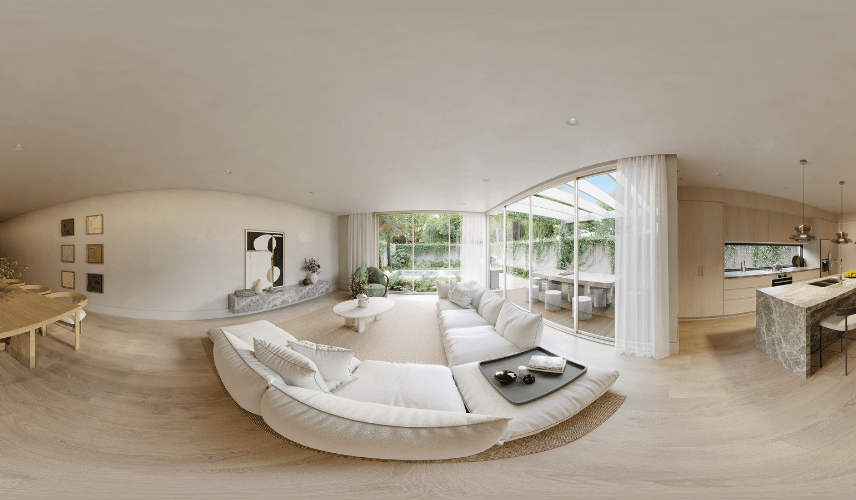
Modern Living Space with a Curved Glass Wall – 3D Rendering Houston project
Strategic questions to ask during a virtual tour
To maximize the value of virtual tours of houses, come prepared with targeted questions:
About dimensions and space: Request exact room measurements and total square footage. Ask if the virtual tour includes a floor plan overlay. Specific numbers help you assess whether spaces meet your needs—particularly for home offices, workshops, or growing families.
About condition and maintenance: Ask directly about any visible damage, recent repairs, or known maintenance issues. A professional real estate agent should be transparent about property condition. Request clarification on any areas that appear worn or problematic in the virtual tour.
About accuracy and representation: Confirm whether virtual tours of houses accurately represent current conditions. Ask when the virtual tour was created. If it’s several months old, request updated images. Inquire about color accuracy and whether staging was used.
About the neighborhood: Since virtual tours of houses typically show interiors, ask about neighborhood characteristics. What’s the street like? How close is the commute to work? What are noise levels like? These details matter tremendously for long-term satisfaction.
About additional features: Request virtual tours of the basement, attic, or any spaces not fully shown. Ask about the garage, driveway, and outdoor amenities. Sometimes virtual tours of houses focus on selling features while downplaying less impressive areas.
Tips for maximizing virtual tours of houses
Prepare in advance before viewing virtual tours of houses. Write down your must-haves and deal-breakers. Note specific features you want to evaluate. This focused approach prevents information overload and helps you assess properties consistently.
Request live virtual tours whenever possible. Virtual tours of houses presented in real-time with an agent allow you to ask immediate questions, request specific angles, and get a sense of the agent’s professionalism and communication style. This interaction often reveals more than passive viewing.
Cross-reference information across multiple sources. Compare virtual tours of houses with listing descriptions, photos, property records, and neighborhood data. Discrepancies between sources might indicate areas worth investigating further.
Use technology features strategically if your virtual tour platform offers them. AR tools let you visualize furniture in empty rooms or preview renovations. Measurement tools help verify spatial relationships. Zoom functions let you examine details closely.
Take notes and screenshots during virtual tours of houses. Document questions that arise, features that appeal to you, and concerns that need follow-up. Having a detailed record helps when comparing multiple properties or discussing options with family members.
Follow up thoroughly after viewing virtual tours of houses. Contact the agent with any unresolved questions. Request additional footage of specific areas. Ask about scheduling an in-person showing. A responsive, helpful agent is a good sign; evasiveness may indicate problems.
Schedule physical viewings strategically after thorough virtual evaluation. Virtual tours of houses should narrow your options significantly. You should visit in-person properties you’re seriously considering, ideally at different times of day to observe lighting and neighborhood activity.
As you embark on your home buying journey, leverage virtual tours of houses strategically. Let them guide your decision-making process while remembering that they complement—rather than replace—professional inspections, financial vetting, and personal intuition. With the right approach to virtual tours of houses, you’ll navigate the buying process more efficiently and confidently than ever before.
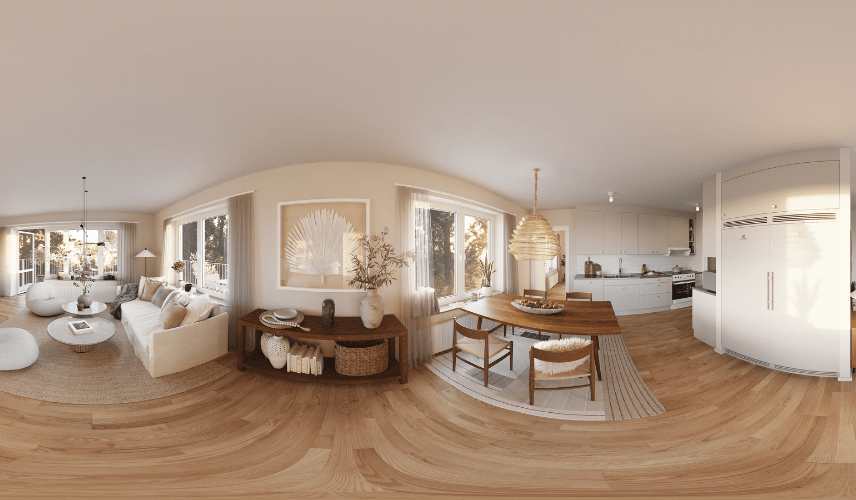
Airy Coastal Living and Dining Area – 3D Rendering Dallas project
Why high-quality virtual tours are indispensable in today’s market
In a real estate landscape that is more competitive and geographically widespread than ever, virtual tours of houses have become a critical tool. They effectively break down barriers, giving prospective buyers—whether they are relocating from another state, evaluating an investment property from overseas, or simply trying to narrow down local options—the power to make informed decisions with unprecedented speed and confidence.
While immensely powerful, it’s essential to view a virtual tour as the vital first step in a comprehensive evaluation, not the final word. The most successful and confident home purchases are made when this digital exploration is followed by traditional due diligence. This is why the quality and accuracy of the tour itself are paramount. Professional visualizations, like those crafted by specialized studios such as MR Rendering, are designed to provide a trustworthy and realistic sense of a home’s layout, scale, and atmosphere. They serve as a reliable foundation, empowering you to proceed with in-person visits, professional inspections, and detailed market research.
| Discover how 3D real estate rendering can boost your sales and impress clients—read more now!
Virtual tours of houses have fundamentally transformed the property evaluation process, offering a level of convenience and insight that was once unimaginable. By appreciating both their incredible strengths and their inherent limitations, you can navigate your home search more effectively.
The key is to use these virtual experiences strategically—as a powerful screening and decision-support tool. Use them to efficiently eliminate properties that don’t align with your needs, to deeply explore the ones that show promise, and to formulate intelligent questions for your in-person viewings. This thoughtful engagement with high-quality virtual tours not only saves significant time and travel expenses but ultimately empowers you to make a more confident and well-considered home purchase.

Content Writer, Copy Writer
As a passionate content writer, Hoang Phuong specializes in creating high-quality, compelling narratives around 3D rendering and architectural visualization. Leveraging deep industry knowledge, Phuong excels at delivering information that is not only clear and creative but also genuinely inspiring, fostering stronger connections with clients and fellow professionals alike.


